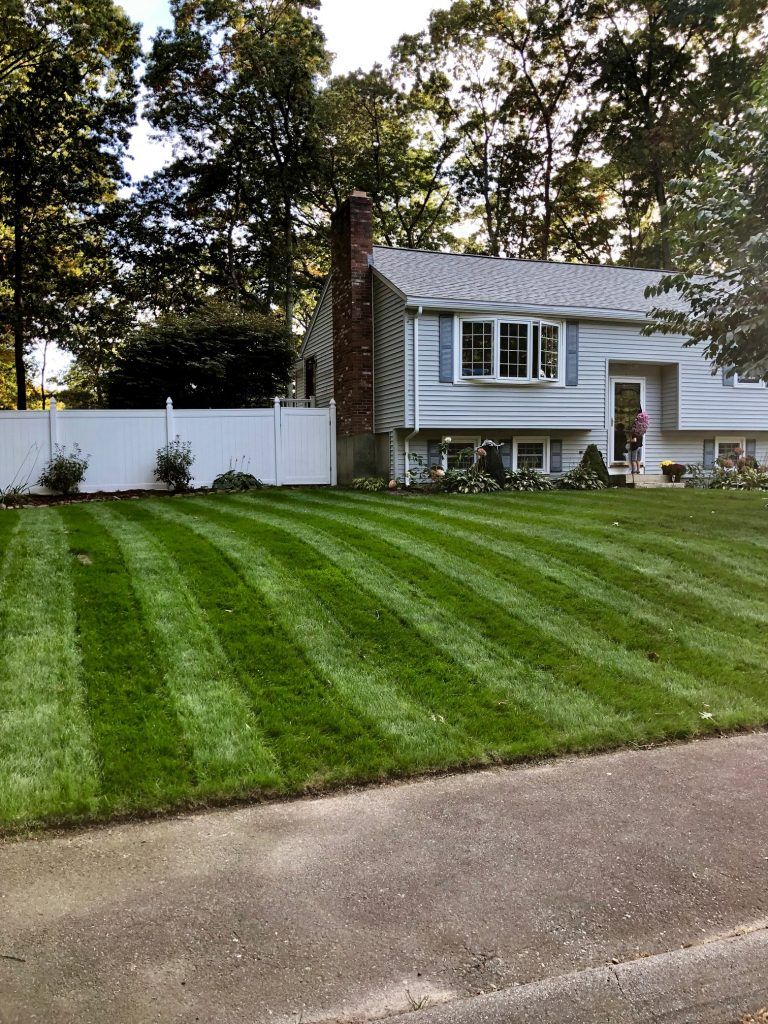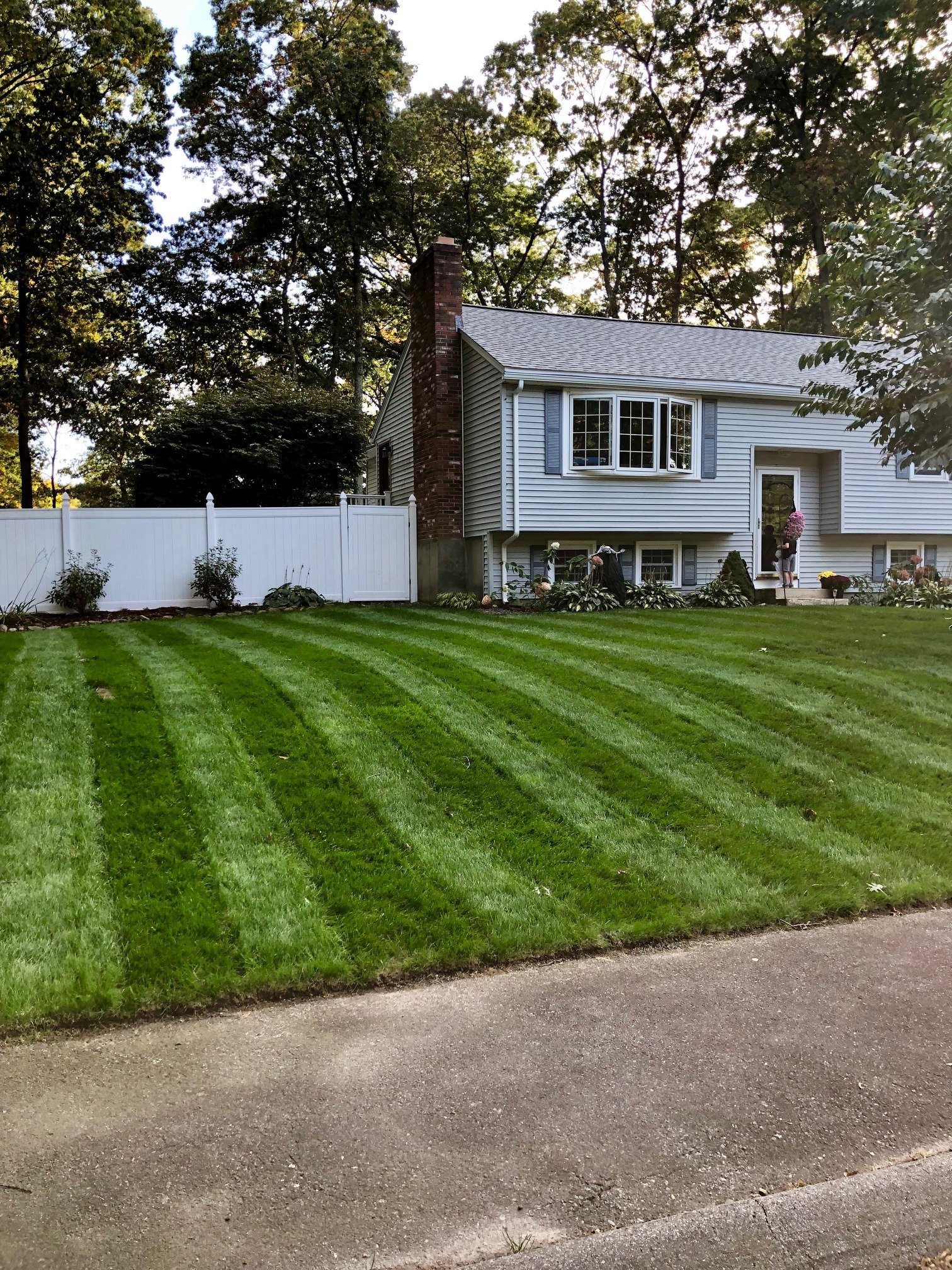
One of the hardest decisions (and jobs) when it comes to your lawn care plan is deciding whether or not you if need to start all over and do a full lawn renovation. To completely renovate your lawn means to kill off your existing lawn and start anew. It takes a lot of work but can be one of the most gratifying projects on your lawn – ever.
Why would you want to renovate your lawn? Maybe you want to establish a healthy lawn with newer cultivars. In my case, I have a hodgepodge of old cultivars (fine fescue) that only look good in May and September. During the hot summer season, the poorly adapted grass species turned brown and went dormant regardless of how much water, sea kelp, humic acid, and Hydretain I use. Thus, with the full sun, I had opted for GCI TTTF.
Maybe you inherited a new lawn filled with weeds. Or maybe you want to try to build a putting green!
This step-by-step list of how to renovate your lawn assumes you have your lawn measurements (in square feet). This is going to dictate how many products and types of machines you need – from grass seed and fertilizer to aerators and lawn rollers.
How long? With a new lawn renovation, plan at least two weeks from start to finish.
Regardless, the absolute best time to fully renovate your lawn is the end of summer and into early fall. Air temps begin to drop, soil temps stay warm, and most of the pesky weeds have already come and gone. For New England lawns, for example (Zone 5-7), begin the process in early-mid August and get your seed down in the first 1-2 weeks of September. Longer germinating grasses like Kentucky Bluegrass (upwards of 3 weeks to germinate) will need to go down a bit sooner than a grass-like Perennial Ryegrass (a week or less).
Lawn Renovation Steps
But first, if you have not conducted a soil test, do so now.
1. Kill the Existing Lawn
This is the longest process in renovating your lawn – spraying and waiting. You will need to use a non-selective herbicide to kill your existing grass. Round-up or products containing glyphosate are common products to use. I, however, opt for a safer option such as Avenger Organics.
These chemicals are foliar, which means the plant will take in the product through its blades. So don’t mow too low before applying.
Consider watering as you normally would in between sprays of chemicals. Why? It will help push up anything that did not get killed in the first round – be it weeds or grass – and ensure you work with as clean of a surface as possible.
Next, you may have to start mowing and bagging your clippings to make sure everything has died off. Rake or a quick dethatch to remove the dead debris is a good idea to again ensure everything is brown.
Regardless of what you choose, read the label and do not exceed the maximum rates. Follow how frequently to apply, and how long after you can seed. This will dictate when you can start the next steps.
2. Scalp the Lawn
Once the lawn has turned brown after one or more applications of a non-selective herbicide, it’s time to mow low. This may be a two or three-step process but lowering your height of cut (HOC) a couple of times. Bag your clippings.
3. Dethatch the Lawn
A manual dethatching rake is the best tool here but is really only suited for small areas (unless you’re hankering for a long workout). A dethatching machine like the Sun Joe dethatcher & scarifier is an awesome option for smaller lawns. I have one for my lawn and it’s amazing. But if you’re pushing 10,000 square feet or more, you may need to hire this part out or rent a machine from your local hardware or tool rental store.
Dethatching is more like raking up the dead debris. All of the dead grass should be gone and expose the dirt as much as possible. This will allow for ideal seed to soil contact.
4. Core Aeration
Removing plugs from your lawn with a core aerator will help allow more air into the soon-to-be root zone, and allow more nutrients, fertilizers, and water to sink deeper into the soil. Aeration will also help relieve compacted soil, which helps roots grow farther downward – where soil compaction can cause the roots to grow upwards.
5. Leveling the Ground (soil/sand)
If you have to regrade your landscape or level some dips in your yard, this is the time to do so. Depending on your soil type will dictate what you use here. However, mason sand – often mixed with an organic matter like screened loam – make the best leveling agents. Use a lawn-level rake or even the backside of a rake to smooth and level the surfaces.
Lightly raking or breaking up the soil will help break up some aeration cores and allow a nice “bed” for the grass seeds.
6. Spread Grass Seed
Depending on which new grass you choose depends on how many pounds per 1,000 sq. ft. you apply. For example, Kentucky Bluegrass (KBG) seeds are much smaller than Turf Type Tall Fescue (TTTF) and are rhizomatic, so you will only be looking around 3-5 lbs. per 1,000 for KGB. However, TTTF may take upwards of 10 lbs. per 1,000 when seeding your newly renovated lawn. Read more on how much grass seed you need.
Choose a good seed blend. One great all-around grass seed to use for cool-season lawns is Jonathan Green Black Beauty Ultra. It contains a mix of the big three grass seeds: KBG, TTTF, fine fescue, and perennial ryegrass. It’s worth the extra money in this step to ensure you have 100% grass and no weed seeds.
Spread the seed using a rotary or drop spreader. Set the hopper to a low setting and be sure to make several passes along the dirt. Think up-down and then left-right (and even diagonally) spreading the seed to ensure you have adequate and even coverage.
Be sure to keep extra grass seed on hand in case you need to spot seed some bare or thin areas.
7. Fertilize
Now that the grass seed is down, the next important step in your lawn renovation is fertilization. This is where you can really cater to your soil test results. Choose a starter fertilizer such as 12-12-12 from Yard Mastery. The lawn will need Phosphorus to help with root development.
Also, consider something for the soil such as Kelp4Less Extreme Blend or Green Lawn & Turf. If you need to adjust the pH, now is a good time for lime or Mag-I-Cal by Jonathan Green. These ingredients over time can also loosen firm soil.
Finally, an optional step is to add Tenacity (Mesotrione) as pre-emergent weed control. This will help suppress any weeds for about 3-4 weeks while your grass begins to germinate and grow.
8. Lightly Rake
Use a metal rake or a garden weasel and lightly rake in the seeds to the soil. This will ensure you have great seed to soil contact. The seeds should not be deeper than 1/4″ below the soil surface. A light rake or roll with the weasel will ensure the seeds are lightly covered, but not buried.
9. Cover & Roll the Grass Seed
Water retention is key, so opt for a light covering of peat moss. Peat moss holds 25 times its weight in water and is the best option. You can use your hands (wear gloves and be prepared to get very dirty) or a peat moss roller. Again, like the step above, you want just a light layer here. Don’t bury or smother the seeds.
You can also look at weed-free straw mats, straw mulch, or my personal favorite, Pennington Slopemaster for hillside areas. In the event of a heavy rainstorm, the grass seed can wash away, and these two options will help limit your losses.
Covering the grass seed not only keeps the seed and soil moist but will help prevent birds from eating too much.
Get yourself a lawn roller for a bonus here. You can roll the peat moss. However, if you use Slopemaster or straw, roll the lawn before applying these ground covers. The light rolling will help with any bumps but also really ensure that all-important seed to soil contact.
10. Watering
Now that the hard work is behind you, we saved the best for last. The single most important step is watering the grass seed. Without water, your seeds will not germinate. Too much could result in flooding or a washout.
How often you water all depends on your weather/climate, the amount of sun/shade your newly renovated lawn gets. You will also benefit from the morning dew. As a general watering guide, your times and duration may look like:
11:00 a.m. (20 minutes)
2:00 p.m. (20 minutes)
5:00 p.m. (20 minutes)
Again, keep the seeds and soil damp (not soaked) is absolutely critical here. Once your seeds germinate and start growing, you can dial the watering back and begin spoon-feeding your lawn.
In the spring, take another soil test early on. Follow our free cool-season lawn care guide to help you keep your new lawn renovation lush and green.
And as always, take pictures of your progress. Renovating your lawn is a lengthy process but a very rewarding one. I hope this step-by-step guide to lawn renovation was helpful. Let me know what you think in the comments below.


Another pro lawn care tip is to use a mulching mower when you mow your lawn. The grass cuttings that are returned to the soil can replace at least half of the nitrogen your lawn needs to stay green and healthy. If you add an overdressing of compost in the spring you can completely remove the need for fertilizers for your lawn.